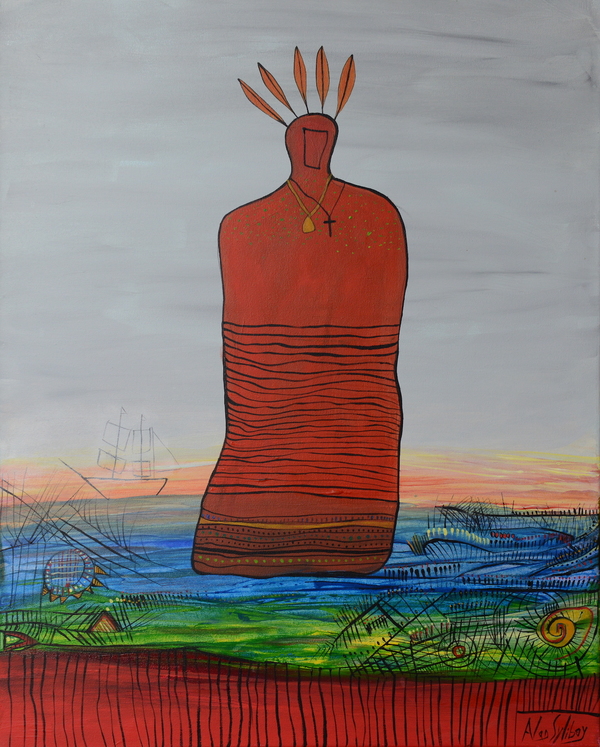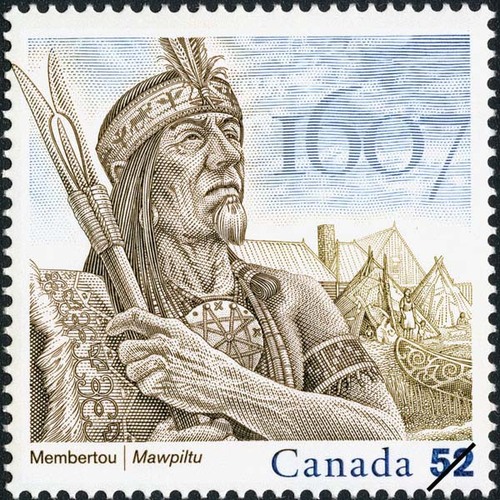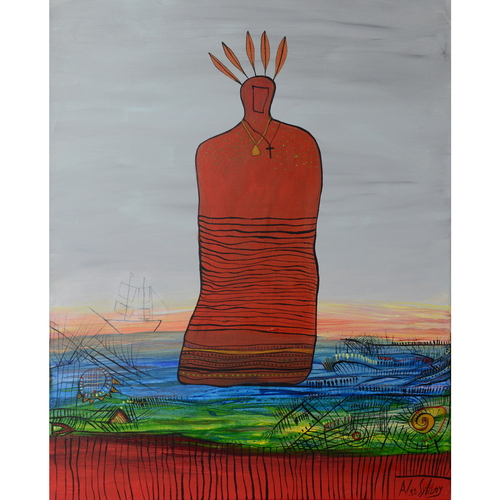
Source: Courtesy of Wikimedia Commons
MEMBERTOU (baptized Henri), Micmac (Mi’kmaq) chief; d. 18 Sept. 1611 at Port-Royal (Annapolis Royal), N.S.
Introduction to the Micmacs and Membertou
Membertou, or Mabretou, as he was called by the explorer Samuel de Champlain, was a Micmac chief who settled in the vicinity of Port-Royal, perhaps in St Marys Bay, probably as early as the mid 16th century. At the beginning of the 17th century, the Micmacs (whom the French at the time called the Souriquois) numbered only around 2,000, according to the Jesuit priest Pierre Biard, because of epidemics resulting from diseases brought by the French. They lived in a territory that included Acadia, Cape Breton Island, and what is known in the early 21st century as the Gaspé region. The peoples whom the French called Etchemins (Maliseet), who occupied the Saint John and St Croix River areas, and the Armouchiquois (Abenakis), who lived on lands farther south, limited their influence.
Membertou’s date of birth is unknown, and there is little information about his life prior to his encounter with the French at the beginning of the 17th century. In the Relations, written by the Jesuits, Marc Lescarbot argued that Membertou would have known the navigator Jacques Cartier and would have been “a hundred and ten or more” in 1610. The exaggeration by the author, who added in La Conversion des sauvages that the chief could “naturally live for over 50 more” years, was nevertheless partly right: Membertou was an old man. He nonetheless still had keen eyesight, remained physically impressive, and was, as Biard recalls in the Relations, “of splendid physique, taller and larger-limbed than is usual among them,… grave and reserved, well aware of his position as commander.” He was also “bearded like a Frenchman, although scarcely any of the others have a hair on the chin,” which would seem to indicate recent intermixing of one of his female ancestors and a European.
Sagamo powers and Membertou
At the beginning of the 17th century Membertou was a sagamo (saqamaw in the Micmac language), meaning a chief. The Micmacs chose their sagamo based on family origins – power was transmitted partly through heredity – and personal qualities. Generosity, for example, was considered to be of particular value, as was bravery in battle. The art of persuasion was also paramount as the sagamo did not exercise his power through coercion but rather by reaching community consensus. In times of peace Membertou received emissaries from neighbouring nations and took charge of allocating hunting grounds. In times of war he was formidable and astute. According to Biard, writing in the Relations, Membertou was “the greatest sagamo, the most closely followed, & the most feared.” He was a master of repartee, a skill he did not hesitate to use against the French. These attributes perhaps explain why Champlain, for his part, accorded him the “reputation of being the most wicked and treacherous of anyone in his nation’s history.” As Lescarbot wrote in his Histoire de la Nouvelle France, Membertou considered himself the equal of the French king and his lieutenants. Furthermore, the Relations reveal that other Micmac chiefs shared his view.
One exploit attests to Membertou’s abilities. In 1606, in reprisal for the deaths of some of their members, the Abenakis killed the Micmac chief Panounias. Membertou organized his retaliation over the course of the following winter and, in the spring of 1607, led a punitive expedition of 400 warriors in a surprise offensive. He was unarmed when he appeared before the Abenakis, feigned the wish to negotiate, and then, as Lescarbot describes in La Défaite des sauvages, ‟suddenly he and his men seized the weapons he had set out” and attacked. Many Abenaki chiefs died, whereas Membertou’s party incurred not a single loss.
Membertou’s influence also extended to religious matters, as he was a buoin, or autmoin (medicine man). The spirit world permeated the daily life of the Micmacs, and anyone could interpret dreams or have visions. Some, however, namely the autmoins, were recognized for their special powers, which included predicting the future, anticipating the outcome of the hunt, rendering oracles, or soothing the sick. Because it was believed that Membertou possessed this supernatural gift, in addition to his qualities as chief, he earned further prestige, as Biard attests in the Relations: ‟It sometimes happens that one same being is all things together & Autmoin & Sagamo, & then he is greatly feared. Such was the renowned Membertou.”
Relations with the French
Membertou’s influence, which was already considerable before the explorer Pierre Dugua de Monts settled at Port-Royal in 1605, increased because of his good relations with the French. According to Lescarbot, the fact that he could benefit from their protection might have determined the way in which the chief forged links with the newcomers. If it is true that self-interest played a part, it did not prevent the establishment of a relationship of trust between the French and Membertou. In mid July 1606, when all but two colonists decided to return to France because they no longer had the means to survive, Membertou agreed to take charge of Port-Royal. En route the French crossed paths with those bringing fresh supplies near Cape Sable and were finally able to return to their habitation. In the winter it was the Frenchmen’s turn to feed Membertou, his family, and those close to him; all were facing starvation. During the summer of 1607, following the revocation of the fur-trade monopoly that had been granted to Dugua, and the necessity for the colonists to return to their country, the Micmac chief again took care of the habitation at Port-Royal; he did so on this occasion for a lengthy period, until the French came back at the beginning of June 1610.
Baptism of Membertou and extended family
Scarcely a few weeks after their return, a number of the French organized Membertou’s baptism, one of the best-known events of his life. He was already initiated into Christianity, and by order of the lieutenant-governor of Acadia, Jean de Biencourt de Poutrincourt et de Saint-Just, as Lescarbot describes in the Relations,” Membertou had his memory refreshed about certain teachings of the Christian Religion that had once been imparted to him.” The catechism was brief, and on 24 June 1610, the feast day of Saint John the Baptist, the missionary priest Jessé Fléché heard the great chief’s confession and baptized him, along with 20 members of his extended family; they became the first people of the First Nations to be baptized by the French. They all received new names inspired by those of the royal family or illustrious Roman Catholics. Membertou became Henri. His wife and daughter, whose usual names are unknown, were given the first names Marie and Marguerite. His sons Membertoucoïchis, Actodin, and Actaudinech’ took the names Louis, Philippe, and Paul respectively. “Thereupon each one sang the Te Deum with good courage, & … the canons [were] fired with great joy,” recounted Lescarbot in the Relations. Membertou, it seems, subsequently attended services regularly and wore a cross on his chest.
It is not known why Membertou and his family agreed to be baptized. For Membertou, perhaps it represented a variation of the resurrection ceremony of the chiefs, during which, as in baptism, the name of the deceased sagamo is transferred to his successor. It is equally possible that the chief believed that adhering to Christianity was a kind of logical consequence of the alliance with the French, with baptism seen as a diplomatic ritual that would consolidate the union. Whatever his motives, Membertou nevertheless did not renounce the traditional spiritual practices of his people. The coexistence of the two worlds – Micmac and Christian – was in fact perfectly possible for the First Nations. An episode that attests to this possibility occurred during the illness of one of Membertou’s sons, Actodin. When Actodin was thought to be in danger of dying, it was decided that dogs would be sacrificed, a classic ritual to ward off disease, calm storms, or accompany the deceased to their burial place. The slaughter, to which the newly baptized Membertou had no objection, was prevented at the last minute because of the intervention of Father Biard, who protested to the chief about the practice.
Despite this incident – which was incomprehensible to the French, for whom conversion excluded on principle any ritualistic animal sacrifices – Membertou apparently died a good Christian according to the standards of the missionaries. At the end of August 1611 the chief, suffering from dysentery, asked to be taken to the Jesuit hut at Port-Royal. Placed in the care of the Jesuit fathers Énemond Massé and Biard, he hesitated a while before agreeing to be buried in Christian soil at Port-Royal, rather than according to Micmac death rites. He died on 18 Sept. 1611, and as Biard recorded in the Relations, he was interred the next day during a ceremony “imitating as closely as possible the honours given in France to great Captains and Nobles.”
Assessment
Charismatic, intelligent, and respected both by his people and the French, Membertou was a renowned and powerful Micmac chief when he met the French. He is mainly regarded as the first chief of a First Nations community to be converted by Catholic missionaries. After examining what is known about his life, however, one realizes that it cannot be reduced to that single spiritual dimension. Membertou was indeed a sagamo whose personal and diplomatic qualities visibly impressed the French to the point that, on his death, he was accorded the honours reserved for men of high rank.
The 1959 edition of R. G. Thwaites’s The Jesuit relations and allied documents: travels and explorations of the Jesuit missionaries in New France, 1610–1791: the original French, Latin and Italian texts, with English translations and notes (36v. in 36, New York) was used for this biography [see Paul Le Jeune].
Pierre Biard, The Jesuit mission in Acadie and Norembègue: 1611–1613, trans. George Topp and William Lonc, ed. Lucien Campeau (Halifax, 2005). F.‑M. Bibaud, Biographie des sagamos illustres de l’Amérique septentrionale … (Montréal, 1848); Le panthéon canadien: choix de biographies, Adèle et Victoria Bibaud, édit. (nouv. éd., Montréal, 1891). T. J. Campbell, Pioneer priests of North America, 1642–1710 (rev. ed., 3v., New York, 1913–16), 2. Lucien Campeau, Jesuit mission to the Souriquois in Acadia: 1611–1613, trans. William Lonc and George Topp (Halifax, 2004). [Samuel de Champlain], Œuvres de Champlain, C. H. Laverdière, édit. (2e éd., 5 tomes en 6v., Québec, 1870). Elie de Comminges, “Les récits de voyage des jésuites en Nouvelle France: la mission du père Biard (1611–1613),” French Rev. (Champaign, Ill.), 49 (1975–76): 840–55. Robert Conkling, “Legitimacy and conversion in social change: the case of French missionaries and the northeastern Algonkian,” Ethnohistory (Tucson, Ariz.), 21 (1974): 1–24. Peter Cook, “Vivre comme frères: Native–French alliances in the St Lawrence Valley, 1535–1667” (phd thesis, McGill Univ., Montreal, 2008). Denys Delâge, “Regards croisés sur les chiens en contexte colonial canadien,” dans La nature des esprits dans les cosmologies autochtones, sous la dir. de F.‑B. Laugrand et J. G. Oosten (Québec, 2007), 279–321. N.‑E. Dionne, “Fleurs de nos forêts: Membertou, le grand Souriquois,” Le Messager canadien du Sacré-Cœur (Montréal), 11 (1902): 173–77; “Le plus grand des Souriquois,” Rev. canadienne (Montréal), 26 (1890): 577–86; Samuel Champlain, fondateur de Québec et père de la Nouvelle-France: histoire de sa vie et de ses voyages (2v., Québec, 1891–1906); Serviteurs et servantes de Dieu en Canada: quarante biographies (Québec, 1904), 253–58. W. C. Gaynor, “A great Indian chief,” New Brunswick Magazine (Saint John), 4 (1904): 129–40, 273–79. B. G. Hoffman, “The historical ethnography of the Micmac of the sixteenth and seventeenth centuries” (phd thesis, Univ. of Calif., Berkeley, 1955). A.‑C. Hornborg, “Visiting the six worlds: shamanistic journeys in Canadian Mi’kmaq cosmology,” Journal of American Folklore (Champaign), 119 (2006): 312–36. Elizabeth Jones, Gentlemen and Jesuits: quests for glory and adventure in the early days of New France (Toronto, 1986). D. J. Leech, “Strength through sharing: Mi’kmaq political thought to 1761” (phd thesis, Univ. of Ottawa, 2006). [Marc Lescarbot], La conversion des sauvages qui ont esté baptizés en la Nouvelle France, cette année 1610 … (Paris, 1610); La défaite des sauvages armouchiquois par le sagamos Membertou … (Paris, [1607]); Histoire de la Nouvelle France … (Paris, 1609). [A. M.] Machar and T. G. Marquis, Stories from Canadian history: based upon “Stories of New France,” ed. T. G. Marquis (Toronto, 1893). L. J. McMillan, “Mi’kmawey Mawio’mi: changing roles of the Mi’kmaq Grand Council from the early seventeenth century to the present” (ma thesis, Dalhousie Univ., Halifax, 1996). Monumenta Novæ Franciæ, Lucien Campeau, édit. (9v., Rome et Québec, 1967–2003; Rome et Montréal, 1989–2003), 1 (La première mission d’Acadie (1602–1616)). [F.‑E.] Rameau [de Saint-Père], Une colonie féodale en Amérique (L’Acadie, 1604–1710) (Paris, 1877). Rémi Savard, L’Algonquin Tessouat et la fondation de Montréal: diplomatie franco-indienne en Nouvelle-France: essai (Montréal, 1996). E. R. Seeman, “Reading Indians’ deathbed scenes: ethnohistorical and representational approaches,” Journal of American Hist. (Bloomington, Ind.), 88 (2001–2): 17–47. François Trudel, “Inuit, Amerindians and Europeans: a study of interethnic economic relations on the Canadian southeastern seaboard (1500–1800)” (phd thesis, Univ. of Conn., Storrs, 1981). Marcel Trudel, Histoire de la Nouvelle France (6 tomes en 7v., Montréal, 1955–99), 2 (Le comptoir, 1604–1627). L. F. S. Upton, Micmacs and colonists: Indian–White relations in the Maritimes, 1713–1867 (Vancouver, 1979). W. D. Wallis and Ruth Sawtell Wallis, The Micmac Indians of eastern Canada (Minneapolis, Minn., 1955).
Cite This Article
Stéphanie Béreau, “MEMBERTOU (baptized Henri),” in Dictionary of Canadian Biography, vol. 1, University of Toronto/Université Laval, 2003–, accessed December 31, 2025, https://www.biographi.ca/en/bio/membertou_1E.html.
The citation above shows the format for footnotes and endnotes according to the Chicago manual of style (16th edition). Information to be used in other citation formats:
| Permalink: | https://www.biographi.ca/en/bio/membertou_1E.html |
| Author of Article: | Stéphanie Béreau |
| Title of Article: | MEMBERTOU (baptized Henri) |
| Publication Name: | Dictionary of Canadian Biography, vol. 1 |
| Publisher: | University of Toronto/Université Laval |
| Year of publication: | 1966 |
| Year of revision: | 2020 |
| Access Date: | December 31, 2025 |




